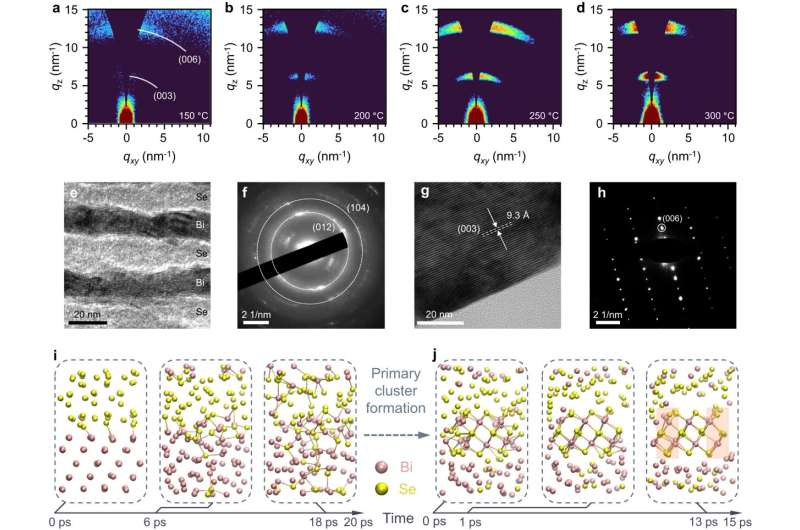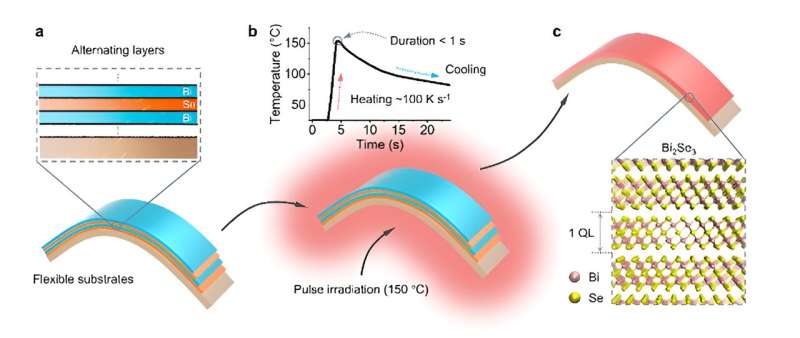This article has been reviewed according to Science X's editorial process and policies. Editors have highlighted the following attributes while ensuring the content's credibility:
fact-checked
peer-reviewed publication
trusted source
proofread
Low-temperature pulse irradiation technique enables flexible optoelectronic devices

The synthesis of metallic inorganic compound thin films typically requires high-temperature processes, which hampers their applications on flexible substrates. Recently, a research team at City University of Hong Kong (CityUHK) developed a pulse irradiation technique that synthesizes a variety of thin films in an extremely short time under ultra-low temperature.
The strategy effectively addresses the compatibility and cost issues of traditional high-temperature synthesis, and the prepared thermoelectric films exhibit excellent optoelectronic performance in the visible and near-infrared spectrum range, which is promising for wearable electronics and integrated optoelectronic circuits.
"Scalable film fabrication is key to meeting the requirements of next-generation optoelectronic devices. Our progress in this work ingeniously avoids the difficulties with traditional thin film preparation techniques, making it more broadly applicable for practical use," said Professor Johnny Ho, Associate Vice-President (Enterprise) and Professor in the Department of Materials Science and Engineering at CityU, who led the study.
The key advantage of the low-temperature synthesis technique developed in this study is its applicability to various flexible substrates. The research team also made an intriguing discovery regarding the thermal effect of these substrates on the optoelectronic response of the resulting thermoelectric thin films. This finding opens up opportunities for achieving wide-spectrum detection capabilities.
The paper, titled "Pulse irradiation synthesis of metal chalcogenides on flexible substrates for enhanced photothermoelectric performance," is published in the journal Nature Communications.

The demand for flexible optoelectronic devices has spurred the need for advanced techniques with high throughput and low processing temperatures. However, when crystalline films are required, additional high-temperature processes are required. This requirement poses significant challenges when working with thermally unstable substrates and other device components.
To overcome these obstacles, the research team developed a novel pulse irradiation synthesis method that achieves both a low processing temperature and an ultra-short reaction time, surpassing the capabilities of conventional techniques.
With the new method for preparing metal sulfide thin films at low temperatures, these detectors can now achieve higher performance on suitable flexible substrates. This creates exciting possibilities for thermal imaging applications in security monitoring, fire detection, military surveillance, and other fields.
Additionally, the photothermoelectric effect allows for the conversion of invisible infrared light into electrical signals, paving the way for applications in high-speed communications and optical signal processing.
Looking ahead, the research team's plans involve primarily optimizing performance and adjusting parameters, expanding material systems, and exploring the integration and feasibility of practical applications. These efforts aim to further enhance the potential of low-temperature synthesized metallic inorganic compound thin films and pave the way for the realization of advanced flexible optoelectronic devices.
More information: Yuxuan Zhang et al, Pulse irradiation synthesis of metal chalcogenides on flexible substrates for enhanced photothermoelectric performance, Nature Communications (2024). DOI: 10.1038/s41467-024-44970-4
Journal information: Nature Communications
Provided by City University of Hong Kong





















